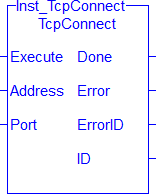TcpConnect
![]()
 Function Block
Function Block![]() A function block groups an algorithm and a set of private data. It has inputs and outputs. - Creates a new socket and performs the connect operation.
A function block groups an algorithm and a set of private data. It has inputs and outputs. - Creates a new socket and performs the connect operation.
Inputs
|
Input |
Data Type |
Range |
Unit |
Default |
Description |
|---|---|---|---|---|---|
|
Execute |
BOOL |
0, 1 |
N/A |
No default |
On the rising edge |
|
Address |
STRING |
N/A |
N/A |
No default |
The IP Address of the remote server. |
|
Port |
DINT |
N/A |
User units |
No default |
The network port to use. |
Outputs
|
Output |
Data Type |
Range |
Unit |
Description |
|---|---|---|---|---|
|
Done |
BOOL |
|
|
If TRUE, the command completed successfully. |
|
Error |
BOOL |
|
|
If TRUE, an error has occurred. |
|
ErrorID |
DINT |
|
|
Indicates the error if Error output is TRUE. See the table in Search IndexFile and TCP/IP Function Block ErrorIDs. |
|
ID |
UDINT |
|
|
The ID of the client socket. |
Remarks
-
- It is possible that the function returns a valid socket ID even if the connection to the server is not yet actually performed.
After calling this function, use the TcpIsConnected function block to know if the connection is ready.
- Use the TcpClose function block to release the socket returned by TcpConnect.
- This function block uses the default TCP settings and a specified server address and port.

Figure 6-280: TcpConnect
FBD Language Example
Not available.
FFLD Language Example
Not available.
IL Language Example
Not available.
ST Language Example
(* TcpConnect example *)
CASE StepCounter OF
0:
Inst_TcpConnect(TRUE, '192.168.1.1', 1234);
StepCounter := StepCounter + 1;
1:
Inst_TcpConnect(TRUE, '192.168.1.1', 1234);
IF Inst_TcpConnect.Done THEN
MySocketID := Inst_TcpConnect.ID;
Inst_TcpConnect(FALSE, '', 0);
StepCounter := StepCounter + 1;
END_IF;
END_CASE;
See Also






